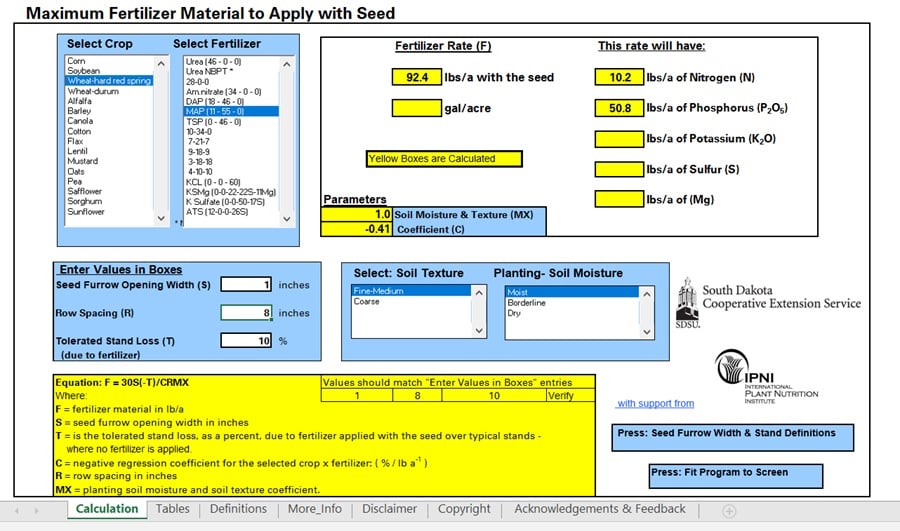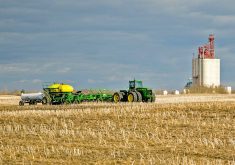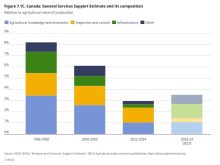Starter fertilizer placed with or near the seed is essential for vigorous early-season growth in grass crops such as corn and wheat.
We plant these crops early because we know vigorous early-season growth is important to high yields. Early seeding also means cold soils. Starter fertilizer is an insurance policy to get the crop off to a fast start despite cold soil conditions.

Each year we receive many questions about starter fertilizer placement and rates. These questions are the result of growers wanting to plant as many acres per day as possible, take advantage of more efficient banded P fertilizer, and of course lower fertilizer costs.
The two most common questions we get are, “What is the highest rate of starter fertilizer I can apply with the seed?” and, “What is the lowest rate of starter fertilizer I can apply with the seed?” and still get a starter effect? South Dakota State University has made a very handy spreadsheet that helps determine the highest safe rate to apply.
The spreadsheet can be downloaded as an XLS file here.
Read Also

Local farm businesses, groups look forward to Manitoba Ag Days 2026
Most of agriculture is seemingly at Manitoba Ag Days each January: Manitoba agribusinesses and farm groups look forward to connecting with farmers at the 2026 show.
This spreadsheet will ask you to input the crop, fertilizer material, seed furrow opening width, row spacing, tolerated stand loss, soil texture, and soil moisture status. After you provide this information, the spreadsheet will calculate the maximum safe rate of various fertilizer sources to apply. The information from this spreadsheet is based on greenhouse and field research from SDSU.
University research shows, that to achieve the full starter effect, a fertilizer granule or droplet must be within 1.5 to 2.0 inches of each seed. If the fertilizer granule or droplet is more than 1.5 to 2.0 inches away from the seed, the starter effect is lost. To show the effect fertilizer rate has on the distance between each seed and fertilizer particle/droplet, we at AGVISE created visual displays. Shown is an example of wheat seeded in seven-inch rows, with 30 lbs./ac. P2O5 (57 lbs. MAP) banded and corn seeded in 30-inch rows with 30 lbs./ac. P2O5 (7.5 gallons 10-34-0) banded. Many thanks to John Heard with Manitoba Agriculture for helping with these displays.
These displays help visualize why lower starter fertilizer rates just won’t cut it for the full starter effect. Remember, starter fertilizer rate must be high enough to keep fertilizer particles/drops within 1.5 to 2.0 inches of each seed.

In addition to starter fertilizer, additional P and K fertilizer is needed to prevent nutrient mining. Nutrient mining, or applying less total fertilizer than the crop removal rate, causes P and K soil test levels to decline over time. Many broadleaf crops are sensitive to seed-placed fertilizer so only low rates of starter fertilizer can be used.
In contrast, most grasses can tolerate much higher rates of P fertilizer with the seed. If you want your starter P fertilizer rate to keep up with crop removal across your rotation, you will need to apply higher rates to crops like wheat and corn. The safe rate of P fertilizer with wheat seed is much higher than crop removal. This allows you to do some catch-up on P for years when you grew soybeans or canola and could only put a low rate of starter P with the seed. If you cannot keep up with P removal in your rotation with normal starter fertilizer rates, you will need to apply additional P in a mid-row band or broadcast application at some point in the rotation.
John Lee is vice-president and director of sales and technical support for AGVISE Laboratories. He is based out of Northwood, North Dakota.















